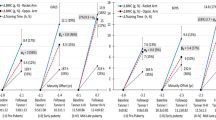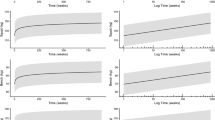Abstract
Summary
Physical activity benefits the skeleton, but there is contrasting evidence regarding whether benefits differ at different stages of growth. The current study demonstrates that physical activity should be encouraged at the earliest age possible and be continued into early adulthood to gain most skeletal benefits.
Introduction
The current study explored physical activity-induced bone adaptation at different stages of somatic maturity by comparing side-to-side differences in midshaft humerus properties between male throwing athletes and controls. Throwers present an internally controlled model, while inclusion of control subjects removes normal arm dominance influences.
Methods
Throwing athletes (n = 90) and controls (n = 51) were categorized into maturity groups (pre, peri, post-early, post-mid, and post-late) based on estimated years from peak height velocity (<−2, −2 to 2, 2 to 4, 4 to 10, and >10 years). Side-to-side percent differences in midshaft humerus cortical volumetric bone mineral density (Ct.vBMD) and bone mineral content (Ct.BMC); total (Tt.Ar), medullary (Me.Ar), and cortical (Ct.Ar) areas; average cortical thickness (Ct.Th); and polar Strength Strain Index (SSIP) were assessed.
Results
Significant interactions between physical activity and maturity on side-to-side differences in Ct.BMC, Tt.Ar, Ct.Ar, Me.Ar, Ct.Th, and SSIP resulted from the following: (1) greater throwing-to-nonthrowing arm differences than dominant-to-nondominant arm differences in controls (all p < 0.05) and (2) throwing-to-nonthrowing arm differences in throwers being progressively greater across maturity groups (all p < 0.05). Regional analyses revealed greatest adaptation in medial and lateral sectors, particularly in the three post-maturity groups. Years throwing predicted 59% of the variance of the variance in throwing-to-nonthrowing arm difference in SSIP (p < 0.001).
Conclusion
These data suggest that physical activity has skeletal benefits beginning prior to and continuing beyond somatic maturation and that a longer duration of exposure to physical activity has cumulative skeletal benefits. Thus, physical activity should be encouraged at the earliest age possible and be continued into early adulthood to optimize skeletal benefits.



Similar content being viewed by others
References
Bailey DA, McKay HA, Mirwald RL, Crocker PR, Faulkner RA (1999) A six-year longitudinal study of the relationship of physical activity to bone mineral accrual in growing children: the university of Saskatchewan bone mineral accrual study. J Bone Miner Res 14:1672–1679
Baxter-Jones AD, Faulkner RA, Forwood MR, Mirwald RL, Bailey DA (2011) Bone mineral accrual from 8 to 30 years of age: an estimation of peak bone mass. J Bone Miner Res 26:1729–1739
Slemenda CW, Reister TK, Hui SL, Miller JZ, Christian JC, Johnston CC Jr (1994) Influences on skeletal mineralization in children and adolescents: evidence for varying effects of sexual maturation and physical activity. J Pediatr 125:201–207
Johnell O, Kanis JA, Oden A, Johansson H, De Laet C, Delmas P et al (2005) Predictive value of BMD for hip and other fractures. J Bone Miner Res 20:1185–1194
Hernandez CJ, Beaupre GS, Carter DR (2003) A theoretical analysis of the relative influences of peak BMD, age-related bone loss and menopause on the development of osteoporosis. Osteoporos Int 14:843–847
Gordon CM, Zemel BS, Wren TA, Leonard MB, Bachrach LK, Rauch F et al (2017) The determinants of peak bone mass. J Pediatr 180:261–269
Rizzoli R, Bianchi ML, Garabedian M, McKay HA, Moreno LA (2010) Maximizing bone mineral mass gain during growth for the prevention of fractures in the adolescents and the elderly. Bone 46:294–305
Weaver CM, Gordon CM, Janz KF, Kalkwarf HJ, Lappe JM, Lewis R et al (2016) The National Osteoporosis Foundation’s position statement on peak bone mass development and lifestyle factors: a systematic review and implementation recommendations. Osteoporos Int 27:1281–1386
Kannus P, Haapasalo H, Sankelo M, Sievänen H, Pasanen M, Heinonen A et al (1995) Effect of starting age of physical activity on bone mass in the dominant arm of tennis and squash players. Ann Intern Med 123:27–31
Heinonen A, Sievanen H, Kannus P, Oja P, Pasanen M, Vuori I (2000) High-impact exercise and bones of growing girls: a 9-month controlled trial. Osteoporos Int 11:1010–1017
Ducher G, Daly R, Bass S (2009) The effects of repetitive loading on bone mass and geometry in young male tennis players: a quantitative study using magnetic resonance imaging. J Bone Miner Res 24:1686–1692
MacKelvie KJ, Khan KM, McKay HA (2002) Is there a critical period for bone response to weight-bearing exercise in children and adolescents? A systematic review. Br J Sports Med 36:250–257
Lappe JM, Watson P, Gilsanz V, Hangartner T, Kalkwarf HJ, Oberfield S et al (2015) The longitudinal effects of physical activity and dietary calcium on bone mass accrual across stages of pubertal development. J Bone Miner Res 30:156–164
Rantalainen T, Weeks BK, Nogueira RC, Beck BR (2015) Effects of bone-specific physical activity, gender and maturity on tibial cross-sectional bone material distribution: a cross-sectional pQCT comparison of children and young adults aged 5-29 years. Bone 72:101–108
Warden SJ, Fuchs RK, Castillo AB, Nelson IR, Turner CH (2007) Exercise when young provides lifelong benefits to bone structure and strength. J Bone Miner Res 22:251–259
Warden SJ, Galley MR, Hurd AL, Richard JS, George LA, Guildenbecher EA et al (2014) Cortical and trabecular bone benefits of mechanical loading are maintained long-term in mice independent of ovariectomy. J Bone Miner Res 29:1131–1140
Warden SJ, Mantila Roosa SM, Kersh ME, Hurd AL, Fleisig GS, Pandy MG et al (2014) Physical activity when young provides lifelong benefits to cortical bone size and strength in men. Proc Natl Acad Sci U S A 111:5337–5342
Bass SL, Saxon L, Daly RM, Turner CH, Robling AG, Seeman E et al (2002) The effect of mechanical loading on the size and shape of bone in pre-, peri-, and postpubertal girls: a study in tennis players. J Bone Miner Res 17:2274–2280
Kontulainen S, Sievanen H, Kannus P, Pasanen M, Vuori I (2003) Effect of long-term impact-loading on mass, size, and estimated strength of humerus and radius of female racquet-sports players: a peripheral quantitative computed tomography study between young and old starters and controls. J Bone Miner Res 18:352–359
Warden SJ, Bogenschutz ED, Smith HD, Gutierrez AR (2009) Throwing induces substantial torsional adaptation within the midshaft humerus of male baseball players. Bone 45:931–941
Malina RM, Bouchard C (2004) Growth, maturation, and physical activity, 2nd edn. Human Kinetics, Champaign
Granados A, Gebremariam A, Lee JM (2015) Relationship between timing of peak height velocity and pubertal staging in boys and girls. J Clin Res Pediatr Endocrinol 7:235–237
Mirwald RL, Baxter-Jones AD, Bailey DA, Beunen GP (2002) An assessment of maturity from anthropometric measurements. Med Sci Sports Exerc 34:689–694
Bogenschutz ED, Smith HD, Warden SJ (2011) Mid-humerus adaptation in fast pitch softballers and the impact of throwing mechanics. Med Sci Sports Exerc 43:1698–1706
Weatherholt AM, Avin KG, Hurd AL, Cox JL, Marberry ST, Santoni BG et al (2015) Peripheral quantitative computed tomography (pQCT) predicts humeral diaphysis torsional mechanical properties with good short-term precision. J Clin Densitom 18:551–559
Doube M, Kłosowski MM, Arganda-Carreras I, Cordelières FP, Dougherty RP, Jackson JS et al (2010) BoneJ: free and extensible bone image analysis in ImageJ. Bone 47:1076–1079
Rantalainen T, Nikander R, Heinonen A, Daly R, Sievänen H (2011) An open source approach for regional cortical bone mineral density analysis. J Musculoskelet Neuronal Interact 11:243–248
Benjamini Y, Hochberg Y (1995) Controlling the false discovery rate: a practical and powerful approach to multiple testing. J Roy Statist Soc Ser B 57:289–300
Robling AG, Burr DB, Turner CH (2001) Recovery periods restore mechanosensitivity to dynamically loaded bone. J Exp Biol 204:3389–3399
Rubin CT, Laynon LE (1984) Regulation of bone formation by applied dynamic loads. J Bone Joint Surg 66A:397–402
Umemura Y, Ishiko T, Yamauchi T, Kurono M, Mashiko S (1997) Five jumps per day increase bone mass and breaking force in rats. J Bone Miner Res 12:1480–1485
Turner CH (1999) Toward a mathematical description of bone biology: the principal of cellular accommodation. Calcif Tissue Int 65:466–471
Schriefer JL, Warden SJ, Saxon LK, Robling AG, Turner CH (2005) Cellular accommodation and the response of bone to mechanical loading. J Biomech 38:1838–1845
Ducher G, Bass SL, Saxon L, Daly RM (2011) Effects of repetitive loading on the growth-induced changes in bone mass and cortical bone geometry: a 12-month study in pre/peri- and postmenarcheal tennis players. J Bone Miner Res 26:1321–1329
Robling AG, Hinant FM, Burr DB, Turner CH (2002) Improved bone structure and strength after long-term mechanical loading is greatest if loading is separated into short bouts. J Bone Miner Res 17:1545–1554
Warden SJ, Hurst JA, Sanders MS, Turner CH, Burr DB, Li J (2005) Bone adaptation to a mechanical loading program significantly increases skeletal fatigue resistance. J Bone Miner Res 20:809–816
Bramble DM, Lieberman DE (2004) Endurance running and the evolution of Homo. Nature 432:345–352
Moore SA, McKay HA, Macdonald H, Nettlefold L, Baxter-Jones AD, Cameron N et al (2015) Enhancing a somatic maturity prediction model. Med Sci Sports Exerc 47:1755–1764
Acknowledgements
The present work was partially supported by the National Institutes of Health/National Institute of Arthritis and Musculoskeletal and Skin Diseases (R01 AR057740 [to S.J.W.]).
Author information
Authors and Affiliations
Corresponding author
Ethics declarations
The study was approved by the Institutional Review Board of Indiana University, and written informed assent was obtained from all participants <18 years of age and written informed consent obtained from all participants ≥18 years of age and parent/guardians of participants <18 years of age.
Conflicts of interest
None.
Electronic supplementary material
ESM 1
(XLSX 15 kb)
Rights and permissions
About this article
Cite this article
Warden, S.J., Weatherholt, A.M., Gudeman, A.S. et al. Progressive skeletal benefits of physical activity when young as assessed at the midshaft humerus in male baseball players. Osteoporos Int 28, 2155–2165 (2017). https://doi.org/10.1007/s00198-017-4029-9
Received:
Accepted:
Published:
Issue Date:
DOI: https://doi.org/10.1007/s00198-017-4029-9




